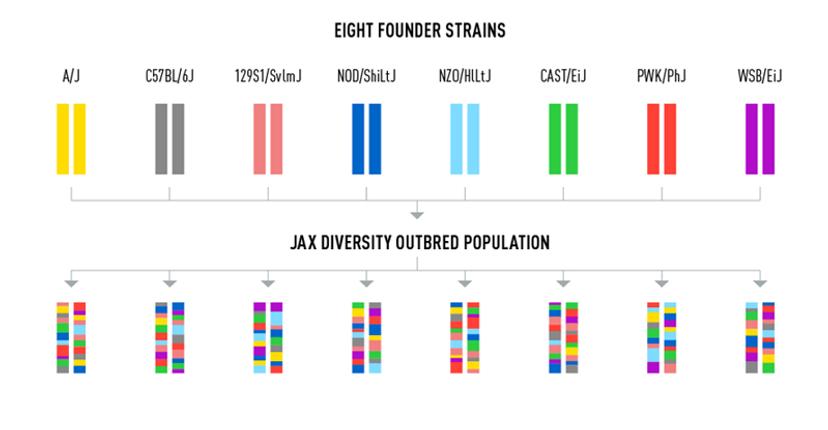How to model human diversity in mice: The case for using genetically diverse outbred mice in research
Find out how the Diversity Outbred mouse platform from The Jackson Laboratory is increasing genetic diversity, and how they are supporting research through a grants program
2 Nov 2022
Dr. Elizabeth Axton from The Jackson Laboratory explains the benefits of using diverse outbred mice in experiments, and grants that can support this
Conventionally, designing studies with mice meant reducing variability as much as possible. To serve that goal, inbred mice have long been used to minimize variables and map genotypes to observed phenotypes. However, in doing so, the translatable power of research findings is often diminished as the experiments have not captured the diverse genetic complexity seen in humans. To better represent human genetic variation, there is growing interest in utilizing outbred mice in research experiments.
As we navigate how to incorporate genetic diversity into mice-based experiments, we speak with an expert at The Jackson Laboratory. In this SelectScience® interview, Dr. Elizabeth Axton, Opportunity Development Manager at The Jackson Laboratory, shares why researchers need to use genetically diverse models, and provides details about a pilot grant program that encourages this approach.
The value of genetic diversity in experimental mice
Research projects in a variety of research areas use mice as subjects to test hypotheses. Commonly, these studies have worked to remove variables for a more tightly controlled experiment, and inbred mice strains such as C57BL/6J from The Jackson Laboratory have enabled this, providing mice with identical genetic backgrounds for research projects.
While these studies support researchers to know that any changes observed are a result of their experimental variable and not genetic differences between the mice, ultimately this is not a realistic scenario when it comes to understanding the real-life impacts of an intervention or treatment. As Axton explains, “The challenge with this approach is that humans are not genetically or environmentally identical to one another. This means, when we test a hypothesis in a single inbred strain, it's equivalent to testing a single human patient.”
“If a mouse-based discovery doesn't translate to humans, we tend to question the reliability of the mouse model when, in reality, it’s probably because we're not utilizing diversity in mouse models,” Axton continues. “Having a genetically diverse mouse model allows us to test hypotheses in a diverse population and observe if an intervention is effective in a diverse population of mice, rather than within a single strain. While it's still a mouse model, it is a big step towards improving the translatability of these findings to humans.”
Diversity outbred mice
The Jackson Laboratory have bred ‘diversity outbred’ (DO) mice specifically to support researchers to improve their research in this way. The difficulty with introducing genetic diversity is in ensuring that the population of mice used is actually diverse enough to properly represent a breadth of genetic lines and traits. Establishing a mouse model like this can be intensive and complex, as Axton explains, “The DO mice were generated by breeding together eight different inbred mouse strains. Using a systematic breeding scheme, we crossed mice strains for many generations to produce a really diverse population of mice where each individual mouse has a unique genetic background and characteristics. The DO mice have over 50 million segregating genetic variants, which is the most diverse mouse population to date. It’s a better representative of our very diverse human genomes. They have, so far, been used in many different fields, such as neurobiology, immunology, toxicology, and more.”

The Jackson Laboratory’s Diversity Outbred (DO) mouse strain breeds together eight strains of mice, with rigorous testing to ensure genetic diversity across generations. jax.org
The potential of DO mice to transform research is great, and using the DO mice from The Jackson Laboratory can save labor and costs. “It simplifies the experimental design,” attests Axton. “There’s no need for laboratories to purchase and breed different inbred strains to create diversity – a large cohort of one population of DO mice can be directly used for experiments.”
Additionally, not only can experiments now represent a broader potential patient group, by using these carefully bred DO mice, researchers can also understand specifically which aspects of genetic diversity are causing differences in results. As Axton elaborates, “What I think is particularly exciting about DO mice is that researchers can now not only test whether their findings are reproducible in a diverse population, but also attribute variability to the underlying genetic makeup of the mice. For example, if variability is observed in the results, it is possible to determine what genetic variants are causing these phenotypes using a process called quantitative trait locus or QTL mapping. So, in addition to achieving reproducibility and translatability of research findings, we can now go deeper into genetics to better explain our observations.”
Supporting the use of DO mice with a pilot grant program
It can be challenging to change established methodologies, and when working with a new mouse strain it can be difficult to know how best to approach experiments in specific fields – but this does not reduce the importance of diversity to answer questions more fruitfully. “Different mouse strains are going to be useful at different experimental stages,” says Axton. “For preliminary or pilot work, or to achieve a quick yes/no answer, inbred strains are probably OK. But once we’ve determined what is working, it might be time to switch to a diversity model and test it. Rather than using inbred mice for all experiments, we need to make space for genetic diversity as well.”
Grant awardees receive up to $10,000 in direct research funds and up to 50 DO mice for research projects.
Dr. Elizabeth Axton The Jackson Laboratory
However, there may be initial barriers or costs associated with switching to using diverse mouse strains. To overcome these and support researchers to utilize and understand the benefits of the DO mouse strain to their research, The Jackson Laboratory have established the Diversity Outbred Pilot Grant Program.
Axton explains more about the program, “In addition to plenty of educational resources on our website, we also have the Diversity Outbred Pilot Grant Program to offer funding opportunities to support researchers and investigate the impact of genetic diversity on experimental outcomes. It is open to researchers in any field. Grant awardees receive up to $10,000 in direct research funds and up to 50 DO mice for research projects. Our goal here is to provide researchers with the tools that they need to get started with using DO mice.”
“These grants are positioned to get quick initial answers that can then be used as preliminary data for another grant application to get more funding or be included as one or two figures in a publication. We’re hoping that the combination of grant funding and free DO mice, along with the educational resources we’ve developed, will provide researchers with the tools needed to take the leap into using genetically diverse outbred mice for the very first time.”
“We’re hoping that our grant can give thousands of scientists the chance to rethink their research techniques and start using DO mice,” Axton concludes. “With more widespread adoption, we hope that genetically diverse mice become just another tool in a mouse researcher's toolkit.”

